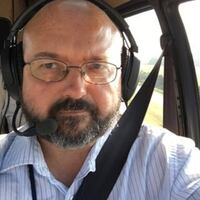The company also has locations on Executive Boulevard and Research Boulevard, not far from the new GE Aviation-Unison Industries home and Northrop Grumman in Beavercreek. The business also has locations in Virginia, Colorado and Michigan.
In all, the business has about 100,000 square feet in the Dayton area.
“It’s headquartered here,” Resonant Sciences Chief Executive J. Micah North, a native of Chattanooga, Tenn., said of Beavercreek. “We started here.”
We caught up with North, 46, co-founder of Resonant, to talk about where his company is and where it’s going. This is an edited transcript of that interview, conducted as he offered a walk-through tour of his company’s latest site at 4501 Indian Ripple Road, a former Vineyard Church youth center.
Dayton Daily News: Readers will want to know how much the Cerberus investment is.
J. Micah North: “I can’t say that.”
DDN: I had to ask.
North: “I know. It’s fair. You can ask anything you want ... They (Cerberus) are really good people. They really understand the company. I’ve known several of the folks there, gotten to know them well. Those guys are kind of a who’s who. Gen. (John W. “Jay”) Raymond (the first chief of space operations of the U.S. Space Force) is working for them, former Lockheed-Martin Skunk work guys, which is where I came from originally. A lot of just great Americans. People really, really focused on the defense of the country, and doing the right thing for the country. It’s more than a money play for them.”
DDN: How did you get on their radar?
North: “You’re working in this community and the circles are pretty small that you run in. Someone recommended us to them. They have a portfolio of companies to help with some programs. And you just got to kind of know them, over a period of a year or so, back and forth on programs. ... We just developed the right relationships there. They were really intrigued by what we do. They said, ‘Hey, we really think this is a national asset to help the country go in the right direction.’”
DDN: In a non-proprietary, layman’s way, can you describe what you do?
North: “We work in three main areas, which are antennas and radomes —radomes are the covers that go outside antennas. Modeling and measurements. We build a lot of radar systems. We probably have one of the most widely used radars in the country, if not the world, that we produce. And then beyond that, we do integrated electronics. We do all sorts of electronics systems for direction-finding, for electronic warfare, electronic protection ...
“Those are kind of the three main areas. And there’s a lot of overlap between those three, which is one of the things that makes us special, really understanding the overlap between those three domains.”
DDN: Are you finding the workers you need?
North: “Dayton is really the best place for building airplanes, by the way. We have the customers. We have the AFRLs (Air Force Research Laboratory). We have the major commands at Wright-Patterson Air Force Base. We have NASIC (National Air and Space Intelligence Center), who understands all of the intelligence stuff that is needed.
“And then you look at what you have, at all of the tooling and die, the automotive industry, and the people-workforce, who understand how to build stuff, who knows how to manufacture. That’s the next big piece.
“So one, you have customers. Two, you’ve got a very smart workforce. And three, you have a great location, in a state that actually cares about building things. Unlike other states, aviation is probably the most important thing in the state of Ohio. At least, they make me feel like it is. So why would you build anywhere else?”
DDN: Why did you need this space?
North: “The business is just growing so fast. ... This is going to be more of our robotics and machining, building and those sorts of the things here (on Indian Ripple Road). Primarily robotics. ... I would call this a robotics and assembly building.
“We’ve gone down the manufacturing path. But we’re still very much known as an R&D house. People come to us with very, very hard problems. We do it all the way from initial concept, all the way up to production and out to the field.
“We can move faster than a lot of the big, traditional defense contractors.”
About the Author



